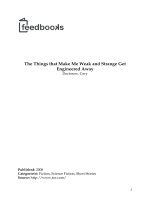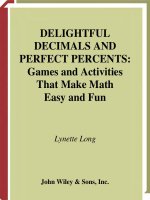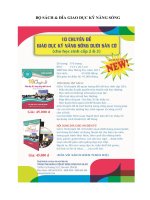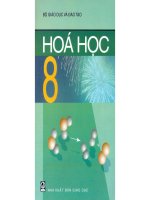Bộ sách Creative activities that make math science fun for kids Cool Flexagon Art
Bạn đang xem bản rút gọn của tài liệu. Xem và tải ngay bản đầy đủ của tài liệu tại đây (5.01 MB, 34 trang )
-TO LIBRAR
Y
HOW
CHECKERB
OA
RD
COOL ART WITH MATH & SCIENCE
FLEXAGON ART
CREATIVE ACTIVITIES THAT MAKE MATH & SCIENCE
FUN FOR KIDS!
ANDERS HANSON AND ELISSA MANN
C O O L A R T W IT H MAT H & SCIEN CE
FLEXAGON ART
CREAT IVE A C TIVITIE S T H A T M A K E M A T H
FUN FOR KIDS!
ANDERS HANSON
&
SC I E N C E
AND ELISSA MANN
V I S IT U S AT W W W. A B DO P U B LI S H I N G.CO M
Published by ABDO Publishing Company, a division of ABDO, P.O. Box 398166, Minneapolis,
Minnesota 55439. Copyright © 2014 by Abdo Consulting Group, Inc. International copyrights
reserved in all countries. No part of this book may be reproduced in any form without written
permission from the publisher. Checkerboard Library™ is a trademark and logo of ABDO Publishing
Company.
Printed in the United States of America, North Mankato, Minnesota
062013
092013
Design and Production: Anders Hanson, Mighty Media, Inc.
Series Editor: Liz Salzmann
Photo Credits: Anders Hanson, Shutterstock
LIBRARY OF CONGRESS CATALOGING-IN-PUBLICATION DATA
Hanson, Anders, 1980Cool flexagon art : creative activities that make math & science fun for kids! / Anders Hanson and
Elissa Mann.
pages cm. -- (Cool art with math & science)
Includes index.
ISBN 978-1-61783-821-7
1. Polyhedra--Models--Juvenile literature. 2. Geometry, Solid--Models--Juvenile literature.
3. Mathematical recreations--Juvenile literature. 4. Paper work--Juvenile literature. I. Mann, Elissa,
1990- II. Title.
QA491.H355 2013
516’.156--dc23
2013001902
C O NT E NT S
4
6
8
10
12
16
C O O L F L E X A GO N A R T
HIDDE N I N T HE FOL DS
P O L Y GO N B A S I C S
SIDES, VERTICES, AND ANGLES
IN THE FOLD
TY P ES OF F L EXAG ON S
FO L D I N G T I PS
MA K E I T EASI ER !
P ROJE C T
1
MA K E A HEXA-T ET R A F L EXAG ON
P ROJE C T
2
MA K E A HEXA-HEXA F L EXAG ON
20
22
26
30
31
31
32
3- D
GEOM ETRY
F R O M S H A P E S TO S O L I DS
PROJEC T
3
M A K E A 3 - D F L E XAG O N
PROJEC T
4
TR A N S FO R M E R STA R
M A TH TERM S
GLOS S A RY
W EB S ITES
INDEX
FLEXAGON ART
HIDDEN IN THE
FOLDS
F
lexagons are toys made of folded paper. The paper is folded so some parts
are hidden. When the folds are flexed, they reveal the hidden parts!
Once you’ve mastered the basic flexagons, there’s even cooler stuff to make.
Build a transforming paper star. Or try your hand at a 3-D flexagon!
4
Most flexagons are flat. You can see the
front and back. But there are more faces.
They can’t be seen until the paper is flexed.
3-D flexagons have an extra dimension.
You can turn them inside out!
5
POL YG O N B A SI C S
SIDES, VERTICES, AND ANGLES
SIDE
F
lexagons are made up of shapes
called polygons. A polygon
is a flat shape with straight sides.
Each point where two sides meet is
called a vertex. For any polygon, the
number of sides equals the number
of vertices. For example, a square
has four sides and four vertices.
VERTEX
ANGLE
SIDE
A SQUARE
VERTEX
When two lines meet at a vertex,
they form an angle. Angles are
measured in degrees.
ANGLE
A TRIANGLE
6
CONVEX OR CONCAVE?
All polygons are either convex or concave. Convex polygons are more
common. In a convex polygon, all of the vertices point away from the center
of the shape. In a concave polygon, at least one vertex points in toward the
center. Both shapes below are hexagons. They each have six sides.
CONVEX HEXAGON
CONCAVE HEXAGON
7
IN TH E FO L D
TYPES OF FLEXAGONS
M
ost flexagons have a square or hexagonal shape. Square flexagons are called tetra
flexagons. They are made of smaller folded squares. Hexagonal flexagons are called
hexa flexagons. They are made of folded triangles.
COMMON FLEXAGON TYPES
TETRA FLEXAGON
HEXA FLEXAGON
8
Some flexagons have more hidden faces than others. The total number of faces a flexagon
has is indicated by a prefix added to its name. For example, a tri-tetra flexagon is a square
flexagon with three faces. A tetra-tetra flexagon is a square flexagon with four faces.
TRI-HEXA WHAT ?!
Think about the words unicycle, bicycle, and
tricycle. Each word has a different prefix.
Uni means one, bi means two, and tri means
three. They are called number prefixes.
A number prefix indicates how much of
something there is.
A unicycle has one wheel and a bicycle
has two wheels. How many wheels does a
tricycle have? How many wheels would a
hexa-cycle have?
9
NUMBER
PREFIX
1
UNI
2
BI
3
TRI
4
TETRA
5
PENTA
6
HEXA
7
HEPTA
8
OCTA
9
ENNEA
10
DECA
F OLD IN G T I P S
MAKE IT EASIER!
M
aking flexagons is fun! It’s even more fun when your projects turn out well. Use the tips
on these pages to help.
Use origami paper or lightweight card
stock. If the paper is too thin, the flexagon
may tear or wrinkle. If the paper is too
thick, it will be difficult to fold and crease.
For glue, use flat-drying paste. It won’t
warp the paper. Scrapbooking glues, such
as Yes! Paste, work well. Don’t use too
much, though. A little glue goes a long way.
10
If you struggle with a project, take a break and come back to it later. It’s easier to solve
problems when you aren’t frustrated.
If you use a template, make the folds exactly
on the lines. The more accurate the folds,
the easier it will be to flex it.
After making a fold, run a fingernail firmly
along it. That’s called creasing. It makes sure
the fold is set. Wooden craft sticks work
well too.
11
12
P ROJE C T
1
MAKE A
HEXA-TETRA
FLEXAGON
STUFF
Y O U´L L
NEED
đƫ SQUARE PIECE
OF PAPER
đƫ PENCIL
đƫ SCISSORS
đƫ MARKERS
TERMS
đƫ ROTATE
đƫ SQUARE
đƫ FACE
A
hexa-tetra flexagon is a square flexagon with
six faces. Fold it in half and open it like a book.
Hidden faces are revealed!
13
4
HOW TO MAKE IT
1 Fold the square paper in half. Crease it
and then unfold it. Fold it in half the other
direction. Crease it and then unfold it.
2 Bring one edge to meet the center crease.
Crease it and then unfold it. Rotate the
paper a quarter turn to the right.
3 Repeat step 2 three times. The paper
should be divided into 16 squares.
Draw along the creases with a pencil.
5
4 Cut out the four middle squares.
5
Label the squares on one side with the
letters AABCCBAABCCB. Start in the top
left square and go clockwise. Write one
letter in each square. Color the squares
that have the same letter the same color.
6
Flip the paper over from left to right.
Label the squares on one side with
the letters DDEFFEDDEFFE. Start at
the top left square and go clockwise.
Write one letter in each square. Color
the squares that have the same letter
the same color. Use different colors
than you used on the other side.
6
14
7
7
Flip the paper back over from left to
right. Fold the left edge to the center.
8 Fold the top edge down to the center.
9
Fold the right edge to the center.
10 Unfold the bottom left fold. Pull the
visible D square up. Underneath will
be another D square. Pinch the D
squares together. Pull the D squares
through the center opening of the
paper. Twist them under the E square.
9
11 Fold the top half of the square back. The
middle fold should point upward. Open
the paper like a book. Rotate the square
a quarter turn. Repeat fold. Open.
Repeat to find every face of the flexagon.
10
15
16
PROJ E C T
2
MAKE A
HEXA-HEXA
FLEXAGON
A
hexa-hexa flexagon is hexagonal. It has a total of
six faces. Four faces are hidden. You can write
secret messages or draw maps on them. Only your
friends will know how to find your messages!
17
STUFF
Y O U´L L
NEED
đƫ PAPER
đƫ SCISSORS
đƫ COLORED
PENCILS
TERMS
đƫ FACE
đƫ EQUILATERAL
TRIANGLE
đƫ HEXAGONAL
2
HOW TO MAKE IT
1 Draw a row of 19 equilateral triangles.
Cut out the row of triangles. Fold and
crease the strip along each line.
2
4
Lay the strip flat with the long edge on
the bottom. Label the triangles with the
letters ABCABCABCABCABCABC. Label
one letter per triangle. Color the triangles
that have the same letter the same color.
3 Flip the strip over. Keep the long edge on
the bottom. Label the triangles with the
letters DDEEFFDDEEFFDDEEFF. Label
one letter per triangle. Color the triangles
that have the same letter the same color.
5
4 Turn the strip back over with the long edge
on the bottom. Fold the left two triangles
under and down. The B triangle should be
behind the C triangle next to it. Then fold
the A triangle under and down. It should
be behind the B triangle next to it. Keep
folding until you get to the end of the strip.
5
18
Now you should have a shorter, folded
strip. Lay it down with an A triangle on the
left. A C triangle should be on the right.
6
6
Fold the left half underneath
the right half. You should
now see four A triangles.
7
Fold the two triangles on the right down
so they are on top. You should
now see five A triangles.
8
Fold the bottom two triangles
up and underneath. Glue the
two blank triangles together.
7
9 Flex your flexagon! Pinch two of the
triangles together so that one point of
every triangle is pointing up. Fold one
of the sides back to reveal a new face.
Continue to pinch and unfold to see
all the different faces of the flexagon.
8
19
3-D
GEOMETRY
FROM SHAPES TO SOLIDS
S
o far you’ve been working with flat shapes. Now let’s look at 3-D solids!
A polyhedron is a 3-D version of a polygon. A polyhedron has flat faces and straight edges.
Body (3-D) The body is the total space a
Faces (2-D) The surface of a polyhedron
polyhedron takes up. It is measured in terms
of volume.
is made of flat polygons. The edges of the
polygons join together. The polygons are called
faces. Faces are measured in terms of area.
20
A point has no dimension. It has no shape that can be measured. A line has one dimension,
length. A flat surface has two dimensions, length and width. A 3-D object has three
dimensions, length, width, and height. How many dimensions do you have?
Edges (1-D) The frame, or skeleton, of a
Vertices (0-D) The edges of a polyhedron
polyhedron is made of straight edges. The
edges are measured in terms of length.
meet at points. The points are called vertices.
They have no dimension.
21
22
P ROJ E C T
3
M A K E A 3-D
FLEXAGON
STUFF
Y O U´L L
NEED
đƫ COPIER OR
SCANNER
đƫ MARKERS OR
COLORED
PENCILS
đƫ SCISSORS
đƫ GLUE
đƫ FOAM BRUSH
TERMS
đƫ 3-D
đƫ DIMENSION
đƫ FACE
đƫ ROTATE
đƫ TRIANGLE
T
ime to add some dimension! This 3-D flexagon has
four faces. One of them is hidden from view. The
cool thing about this project is how it moves. It unfolds
outward from its center as it rotates!
23









